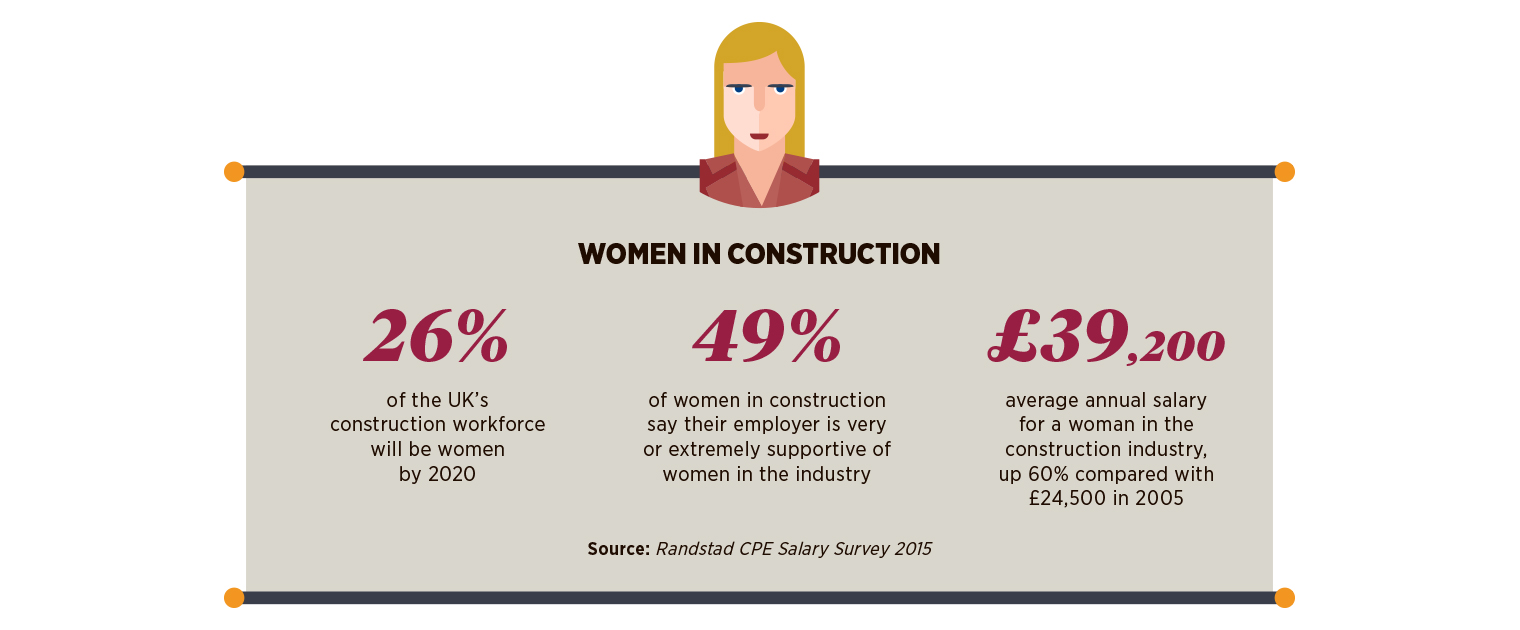Why a career in construction?
A negative public image, tough competition from other sectors and “stop-go” government policies have meant the construction industry must now fight hard to attract the best people
Like most industry sectors, construction is fighting for its share of the talent pool as the UK enters an economic renaissance. But it has a problem that has always put it at a competitive disadvantage – a poor public image.
Until quite recently, unless you were male, had a penchant for cement in your tea, eating sandwiches in a cold, grimey van and inadequate toilet facilities, construction sites held little career appeal.
It’s an image that the industry is working hard to remedy, but sadly one that the media sometimes seems intent on perpetuating. A plethora of rogue traders-type TV shows have turned the menace of the cowboy builder into popular entertainment, tarnishing a large swathe of the industry workforce in the process.
The cyclical nature of the construction industry has further weakened its ability to attract talent.
With major housing shortages, vital infrastructure projects and renewed vigour in the commercial property market, the industry now needs to harness talent on a massive scale
Steve Hindley, chairman of construction firm The Midas Group and the CBI Construction Council, says: “We are susceptible to up and downturns, but over the years successive governments have used construction as a turn-off, turn-on mechanism for stimulating economic activity.
“This has led to the industry laying off more than half a million people over the past two recessions as public-sector work has dried up, creating uncertainty for people looking at the industry as a long-term career option.”
The joint government and industry Construction 2025: strategy document, published in 2013, highlighted the need for fundamental change in how the industry is perceived by the general public, and greater engagement of young people and society at large, as crucial to improving the sector’s image.
With major housing shortages, vital infrastructure projects and renewed vigour in the commercial property market, the industry now needs to harness talent on a massive scale. To do that it has to polish its professional image and diversify its employee landscape.
A sharp rise in the number of women in the industry suggests that progress is being made. Between 2005 and 2010 the proportion of construction jobs filled by women rose by from 15 per cent to 16 per cent, according to Office for National Statistics data. In the last five years it has increased at four times that rate to 20 per cent in 2015.
Women are also filling more senior roles in construction. Fifteen years ago, just 6 per cent held senior management positions or directorships. Today that figure has reached 16 per cent, according to the latest Randstad CPE Salary Survey.
Nevertheless, given the forecasts for global construction industry growth of 70 per cent over the next decade, the sector needs to focus on longer-term talent acquisition and retention.
To stand any chance of plugging the existing skills gaps, diversifying the workforce and securing a talent pipeline for the future, more young people need to be persuaded to pursue careers in construction.
Andrew Bredin, managing director of Hays Construction, says: “To make the industry more attractive to school-leavers and graduates, they should be offered incentives and subsidies for pursuing degrees that equip them to work in construction, while incentives for employers will also help encourage more younger people into apprenticeships.”
As a route to professional qualifications, apprenticeships have elevated the status of NVQs and helped to broaden the appeal of construction to those who may never have considered it as a career.
And as revealed in the Universities UK and UK Commission for Employment and Skills report Forging Futures, employers and universities are collaborating to create more effective routes to the highly skilled jobs crucial to the country’s economic future, including those in construction.
The problem with targeting graduate-level talent, of course, is that every other sector is fighting for the same people.
A better way of securing future talent, at the same time promoting a positive industry image and increasing diversity, is to start younger and collaborate more closely with schools, says Claire Gott, design manager at WSP Parsons Brinckerhoff Design.
“We need to work together to explain to primary and secondary schoolchildren how exciting a career in construction can be, why they should consider a career in this industry and what subjects they should be studying to get there,” she says.
Historically, one of the challenges has been the position of construction in the UK curriculum.
Alison Watson, managing director of Class Of Your Own, a social enterprise for education in the built environment, explains: “When STEM – science, technology, engineering and mathematics – subjects are at the top of the education agenda, there is little focus on introducing young people to the built and natural environment.
“Yet construction is a continually evolving, technically diverse industry of which STEM is the foundation. Educators require more focused support than the industry is currently providing.”
Many of the UK’s leading construction, engineering and building services firms are now running outreach programmes in schools, aimed at inspiring future generations of industry professionals.
But what of the other end of the scale and the many thousands of small and medium-sized firms that make up the bulk of the construction sector, including the tiny plumbing, plastering and carpentry firms operating in the domestic sector?
Arguably, they have suffered most from the industry’s traditional negative image, and therefore face the biggest challenge in attracting and retaining talent.
They have been further impacted by the greater focus that has in the past been placed on attending college and university. This works against the construction industry, as there are fewer courses for trade professions at higher education level. How can the smallest firms recruit the next generation of qualified tradespeople?
“For them, more than any other business in the sector, the answer lies in having a demonstrably good local reputation,” says Liz Male, chairman of TrustMark, a government-endorsed scheme for trusted tradesmen in the domestic sector. “That means building a sustained, positive profile for a business in the local area through great work, customer testimonials and the all-powerful ‘word of mouth’.”
From being the worst hit sector of the 2008 financial crisis, the construction industry is now in the midst of a building boom, with a yawning skills gap. Construction must continue to build on the foundations of what has already been achieved to create a sustainable talent pool for future prosperity.
Also found in #SKILLS GAP #TALENT MANAGEMENT #CONSTRUCTION #RECRUITMENT
- Written by
Alison Coleman, Writer and editor, contributor to Forbes, The Guardian, Director, Economia and Employee Benefits
Article originally published on the Raconteur.
--Future of Construction 15:41, 20 Jun 2017 (BST)
Featured articles and news
Infrastructure that connect the physical and digital domains.
Harnessing robotics and AI in challenging environments
The key to nuclear decommissioning and fusion engineering.
BSRIA announces Lisa Ashworth as new CEO
Tasked with furthering BSRIA’s impressive growth ambitions.
Public buildings get half a million energy efficiency boost
£557 million to switch to cleaner heating and save on energy.
CIOB launches pre-election manifesto
Outlining potential future policies for the next government.
Grenfell Tower Inquiry announcement
Phase 2 hearings come to a close and the final report due in September.
Progress from Parts L, F and O: A whitepaper, one year on.
A replicated study to understand the opinion of practitioners.
ECA announces new president 2024
Electrical engineer and business leader Stuart Smith.
A distinct type of countryside that should be celebrated.
Should Part O be extended to existing buildings?
EAC brands heatwave adaptation a missed opportunity.
Definition of Statutory in workplace and facilities management
Established by IWFM, BESA, CIBSE and BSRIA.
Tackling the transition from traditional heating systems
59% lack the necessary information and confidence to switch.
The general election and the construction industry
As PM, Rishi Sunak announces July 4 date for an election.
Eco apprenticeships continue help grow green workforce
A year after being recognised at the King's coronation.
Permitted development rights for agricultural buildings
The changes coming into effect as of May 21, 2024.

























